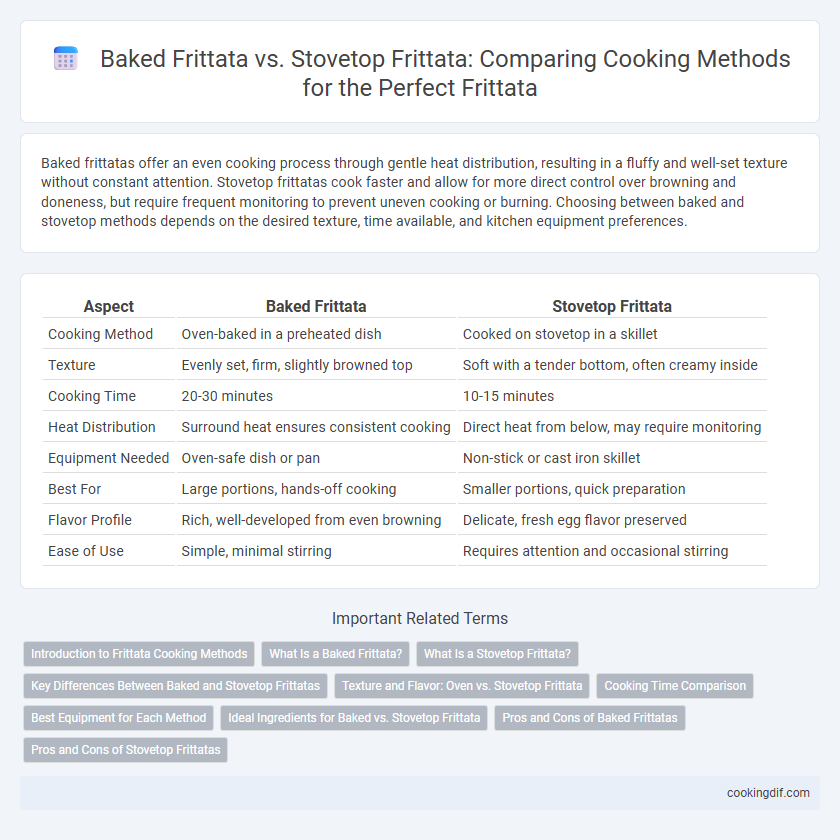Baked frittatas offer an even cooking process through gentle heat distribution, resulting in a fluffy and well-set texture without constant attention. Stovetop frittatas cook faster and allow for more direct control over browning and doneness, but require frequent monitoring to prevent uneven cooking or burning. Choosing between baked and stovetop methods depends on the desired texture, time available, and kitchen equipment preferences.
Table of Comparison
| Aspect | Baked Frittata | Stovetop Frittata |
|---|---|---|
| Cooking Method | Oven-baked in a preheated dish | Cooked on stovetop in a skillet |
| Texture | Evenly set, firm, slightly browned top | Soft with a tender bottom, often creamy inside |
| Cooking Time | 20-30 minutes | 10-15 minutes |
| Heat Distribution | Surround heat ensures consistent cooking | Direct heat from below, may require monitoring |
| Equipment Needed | Oven-safe dish or pan | Non-stick or cast iron skillet |
| Best For | Large portions, hands-off cooking | Smaller portions, quick preparation |
| Flavor Profile | Rich, well-developed from even browning | Delicate, fresh egg flavor preserved |
| Ease of Use | Simple, minimal stirring | Requires attention and occasional stirring |
Introduction to Frittata Cooking Methods
Baked frittatas require an oven, offering even cooking and a firm, sliceable texture, making them ideal for serving multiple portions. Stovetop frittatas cook on the burner, allowing for quicker preparation and more control over browning, but may require finishing under a broiler to set the top. Both methods preserve the frittata's core ingredients like eggs, cheese, and vegetables while delivering distinct textures and flavors.
What Is a Baked Frittata?
A baked frittata is an Italian egg-based dish cooked entirely in the oven, allowing for even heat distribution and a firm yet tender texture throughout. Unlike stovetop frittatas, which start on the heat and often finish under a broiler, baked frittatas develop a golden top and a souffle-like rise by baking at a consistent temperature. This method is ideal for incorporating vegetables, cheeses, and meats evenly without the need for flipping or careful stovetop monitoring.
What Is a Stovetop Frittata?
A stovetop frittata is an Italian-style egg dish cooked primarily on the stove rather than baked in the oven, allowing for a swift and controlled cooking process. This method involves gently cooking eggs and fillings like vegetables, cheese, or meats in a skillet over medium heat, often finishing with a brief broil to set the top. Stovetop frittatas offer a tender texture with slightly crisp edges and provide flexibility for quick meal preparation compared to the longer baking time required for oven-baked frittatas.
Key Differences Between Baked and Stovetop Frittatas
Baked frittatas cook evenly in the oven, resulting in a uniformly set texture and a slightly browned top, making them ideal for larger portions or meal prepping. Stovetop frittatas cook quickly on the burner, offering a creamier texture with a golden crust on the bottom, perfect for smaller servings or quick meals. The key differences lie in cooking time, heat distribution, and texture outcomes, with baked methods providing consistent doneness and stovetop methods allowing more control for variations.
Texture and Flavor: Oven vs. Stovetop Frittata
Baked frittatas develop a firm, custard-like texture with evenly cooked edges and a slightly browned top, enhancing richness and depth of flavor through slow, consistent heat. Stovetop frittatas often have a softer, more tender interior with a lightly crisped bottom and a fresher, more delicate taste due to quicker, direct heat cooking. Choosing the oven method favors uniform texture and caramelized flavor complexity, while stovetop cooking preserves subtle egg flavor and a tender mouthfeel.
Cooking Time Comparison
Baked frittatas typically require 20-30 minutes to cook thoroughly in an oven preheated to 350degF (175degC), allowing even heat distribution and a firm texture. Stovetop frittatas usually take 10-15 minutes over medium heat, relying on direct heat and frequent monitoring to prevent burning while achieving a softer center. The choice between baking and stovetop methods significantly impacts overall cooking duration and texture consistency in frittata preparation.
Best Equipment for Each Method
Baked frittatas require an oven-safe skillet or a glass baking dish to ensure even heat distribution and perfect cooking throughout. Stovetop frittatas are best prepared in a non-stick or cast-iron skillet for superior heat retention and easy flipping. Both methods benefit from a silicone spatula to prevent scratching and to aid in gentle folding.
Ideal Ingredients for Baked vs. Stovetop Frittata
Baked frittatas are ideal for ingredients with higher moisture content, such as tomatoes, zucchini, and spinach, as the even heat distribution in the oven prevents sogginess. Stovetop frittatas work best with heartier vegetables like bell peppers, onions, and mushrooms, which caramelize nicely and maintain structure over direct heat. Cheese varieties like feta and goat cheese complement baked frittatas, melting evenly, while cheddar and parmesan enhance the stovetop version with sharper flavor and browning.
Pros and Cons of Baked Frittatas
Baked frittatas offer even cooking and a firm, sliceable texture, making them ideal for serving multiple portions and meal prepping. They require more time and careful temperature control to avoid drying out or overcooking, unlike stovetop frittatas which cook faster with more control over browning. However, baked frittatas limit direct access for stirring or adding ingredients mid-cook, which can reduce flavor layering compared to stovetop methods.
Pros and Cons of Stovetop Frittatas
Stovetop frittatas offer quick cooking and better control over heat, which allows for a tender, custardy texture without the need for an oven. However, they require careful attention to avoid uneven cooking or burning, and may lack the evenly browned top that baked frittatas provide. This method is ideal for small portions and stovetop-friendly kitchens but is less efficient for larger batches.
Baked Frittata vs Stovetop Frittata for cooking method Infographic

 cookingdif.com
cookingdif.com